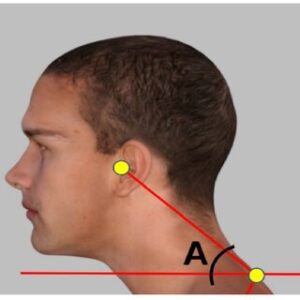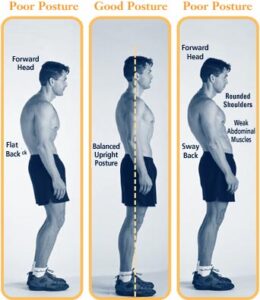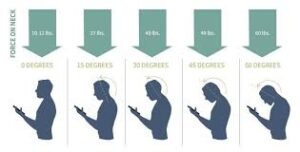If you want to know how I check my forward head posture at home then, you have got to read this article very carefully.
I am not saying that it involves rocket science yet, learning how to test your forward head posture correctly is vital for ensuring your speedy recovery.
My bad neck posture has been troubling me for quite some time now. Nonetheless, I had no idea how to assess the extent of damage it had done to my spinal column, muscles of the neck. I also realized that my nerd neck had damaged my facet joints.
So, I decided to first conduct an ‘at home forward head posture test’.
How I Check My Forward Head Posture at Home Article Contents:
1) What is My Opinion of a Forward Neck?
2) How I Conducted an Accurate At Home Forward Head Posture Test?
3) Does My Forward Head Tilt Add Extra Weight to My Spinal Column?
4) FAQs on Checking Neck Posture at Home
5) Takeaway
What I Believe is a Forward Neck?
I have read several articles and research studies on bad neck posture or vulture neck posture. Nonetheless, it was not until I suffered from bad neck posture did I realize how irritating and uncomfortable this condition could really be.
I had no issue whatsoever walking tall.
This phrase “walking tall” refers to a condition wherein you keep your head high while walking, talking to others or carrying out everyday chores that do not require you to bend.
Optimal Head Posture in My Dreams:
So, while I was maintaining optimal posture (as per my opinion), in reality, I was indeed suffering from a vulture neck posture. Also termed as a crane neck posture, my forward neck was a bit tough to detect.
I came to know of my poor head posture only when the muscles on the sizes of my neck started to pain. My upper back felt rather stiff and my back shoulders muscles were always under constant “fire”.
The Pain and Stiffness Deepened:
As time passed, the pain slipped lower. Now, the middle portion of my back was also in constant pain. The latissimus dorsi as well as the rhomboids muscles felt rather stiff and compressed.
My erector spinae was affected the most. The pain in my upper back muscles was almost constant and although it was feeble, it became a part and parcel of my life.
Soon, I felt as though, it (the aches and stiffness) was a normal part of my existence.
The Spine Surgeon:
It was only when one of my buddies who had recently become a spinal surgeon pointed out that I was indeed suffering from forward head posture did I realize the seriousness of the situation.
The doctor said that my smaller craniovertebral angle was less than the required 48 degrees. He even suggested I undergo cervical fusion to fix my forward head tilt.
This is when I realized that my neck pain and stiffness in the upper back muscles was actually because of my poor neck posture.
Surprisingly, there was no involvement of cellphone or laptop overdose for my bad neck posture.
How I Conducted an Accurate At Home Forward Head Posture Test?
Even before I explain the different techniques that I used to conduct forward head posture test, I would like to explain what a proper head posture is:
Proper Head Posture:
Proper head posture is defined as a neck position wherein your ears are in line with your body’s center of gravity. Basically, your ears are in line with your shoulders.
They can however fall slightly behind your shoulders as well. So, a basic rule of thumb to ascertain whether your head posture is perfect or not is to pinpoint the exact position of your ear lobe. It should be in line with your shoulders.
My “First” Forward Head Posture Test:
In the first test, I made use of the wall of my room and a ruler for measurement.
@ I stood straight with my back towards the wall.
@ I made sure that my butt was touching the wall and my shoulder blades were also touching the wall.
@ My feet were shoulder width apart.
@ Without forcing my head backwards, I stood straight in the same position.
@ I asked my friend to measure the distance between the wall and the back of my head.
@ Using the ruler, he did so. My head was 2 inches ahead of the wall.
This is a clear indicator that I was indeed suffering from bad neck posture. In an ideal scenario, the back of my head should have touched the wall.
My “Second” Forward Head Posture Test:
The second method that I use is to measure my forward head facing angle. The forward head angle is calculated from the base of the neck. This line is followed all the way up till the earlobes.
This forms as the baseline for an optimal neck or head position. The forward shift of my head from this base position is then measured (and determined in degrees).
Here is what I did to achieve this aim:
@ I made an imaginary line that went in a straight line from the far end of my vertebra. Basically, the C7 vertebra that is located at the bottom on my neck.
@ Then, I drew another line that went from the C7 spinous process to the point that lies just in front of my ear holes. This point is also termed as the tragus.
@ Wherever these two lines merged (on the C7 vertebra) became the craniovertebral angle.
@ This measurement displayed my head to be at a 42 degrees angle. So, I was indeed suffering from forward head.
I preferred standing on my feet in order to measure my craniovertebral angle. I could have done so lying down as well but I felt more comfortable and had higher accuracy rate while standing.
Does My Forward Head Tilt Add Extra Weight to My Spinal Column?
After the test results, I often wondered, “how to fix forward head posture fast”. Nonetheless, even before I went in for the nerd neck fix, I researched more about the impact of forward neck on my spinal column.
The Correct Head Position:
So, yes! My research yielded positive results.
I found out that when the head is positioned right above the shoulders wherein the ears are in line with the shoulders then, the weight added to the spine is anywhere in between 10 to 12 pounds.
This is when the craniovertebral angle is 0 degrees.
The 45 Degree Head Drift:
Ironically, when the craniovertebral angle of the head is about 45 degrees then, the load placed onto the spinal column is immense.
When I calculated the weight then, I was astounded to find out that the weight added to the spine was close to 50 pounds.
The 60 Degree Craniovertebral Angle:
Finally, when the craniovertebral angle is 60 degrees or even more then, the load that you add to your spine is almost unimaginable.
It comes out to be in excess of 60 pounds. So, if your craniovertebral angle is sixty degrees then, your spine and neck is bearing a weight that is equivalent to 60 pounds.
FAQs on Checking Neck Posture at Home
Q-1: How can I assess my forward head posture using a wall test?
A-1: Stand with your back against a wall, ensuring your heels, buttocks, and upper back are in contact. Tuck your chin slightly and attempt to touch the back of your head to the wall. If your head doesn’t naturally touch, it indicates a forward head posture.
Q-2: What is the side-view photo method for detecting forward head posture?
A-2: Take a side-profile photo while standing upright. Draw a vertical line from your ear canal down to your torso. If this line falls in front of your body’s midline, it suggests a forward head posture.
Q-3: How can I use a mirror to check my posture?
A-3: Stand in front of a full-length mirror. Ensure your head is erect and not slumping forward or backward. This visual check helps identify any misalignment in your posture.
Q-4: What role does the “double chin” technique play in posture assessment?
A-4: Gently tuck your chin to create a “double chin” effect. If this movement feels unnatural or causes discomfort, it may indicate that your head is positioned too far forward.
Q-5: How can I use a chair to evaluate my posture?
A-5: Sit upright in a chair with back support. Place your feet flat on the floor and ensure your back is straight. If your head leans forward without support, it may indicate a forward head posture.
Regularly performing these assessments can help you monitor and correct forward head posture, promoting better spinal health.
Takeaway
Forward head posture test at home is very important if you would like to maintain optimal head posture at all times. If you follow the above methods that I have mentioned above then, the calculation process becomes simpler.
As per bestforwardheadposturefix.com, “if you have any doubt and you need assistance then, do not hesitate to involve your friend”. When you have a helping hand then, the entire process becomes a breezy task indeed.
So, performing daily self posture checks is the need of the hour if you wish to improve your posture at home.
Your aim should be to maintain a CVA of 50 degrees and more. So, if you can do this, you can avoid suffering from bad neck posture.
Nonetheless, do make a conscious effort to avoid bending your head forward while performing daily chores.
It is also suggested to stop lifting heavy suitcases to avoid forward neck.
At the same time, I would recommend that you get up and take a walk for about 2 minutes after every 15 to 20 minutes of work on the laptop.
The prime aim here should be to make “extra effort” to maintain good body posture.
References:


